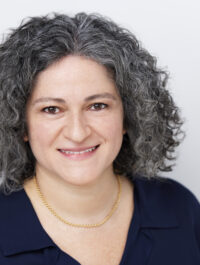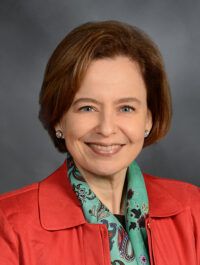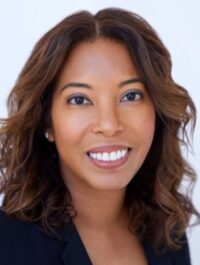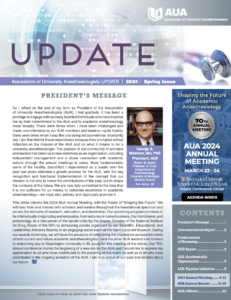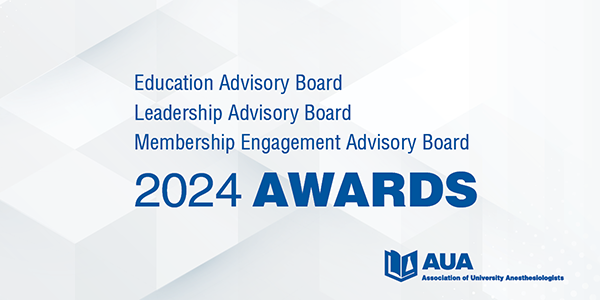Women in Medicine Month: Women in Leadership
“A single conversation with a wise [wo]man is better than ten years mere study of books” - Henry Wadsworth Longfellow.
September is “Women in Medicine” month. Since 2020, we have dedicated the September newsletter of the AUA to women in academic anesthesiology. In this issue, we share the insights of a group of successful women leaders in academic anesthesiology, collected by open-ended survey questions. Each of our contributors is a leader in medicine who has used their position for advocacy and mentorship. Their reflections, their advice, and their insights are presented to recognize their contributions, to learn from their experiences, and to inspire the next generation of leaders in our field. We are grateful for our contributors’ time, candid advice, and thoughtful insights.
Who are the contributors?

Dr. Odinakachukwu Ehie is an Associate Professor of Anesthesiology and Vice Chair for Diversity, Equity, and Inclusion at UCSF
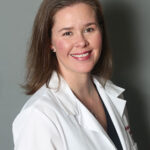
Dr. Emily Gordon is Associate Professor of Anesthesiology at the University of Pennsylvania, Vice Chair of Education and System Director for Cardiovascular Critical Care and Postoperative Care

Dr. Harriet Hopf is a Professor of Anesthesiology, Perioperative, and Pain Medicine and Adjunct Professor of Biomedical Engineering, Executive Director for Faculty Development in and Academic Affairs in Anesthesiology, and the Academic Senate President-elect at the University of Utah

Dr. Lisa Leffert is Professor and Chair of Anesthesiology at Yale University

Dr. Cynthia Lien is Professor and Chair of Anesthesiology at Medical College of Wisconsin

Dr. Daryl Oakes is a Professor of Anesthesiology and Associate Dean for Post-Graduate Medical education at Stanford University. She is also the immediate past Chair of the Women in Cardiothoracic Anesthesia group at the Society of Cardiovascular Anesthesiologists

Dr. Tracey Straker is a Professor of Anesthesiology at Montefiore Medical Center and the Vice Chair for Clinical Operations and DEI officer. She is also the chair of the DEI taskforce in the Society for Education in Anesthesiology, Vice Chair of ASA Committee on Fundamentals of Anesthesiology and Committee on Professional Diversity, Chair of the National Committee on Foreign Medical Education and Accreditation, and member-at-large of the AUA council

Dr. Jeanine Wiener-Kronish is Distinguished Professor and past Chair of Anesthesiology at Massachusetts General Hospital. She is also a past President of the AUA
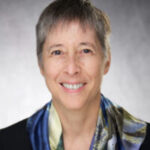
Dr. Cynthia Wong is Professor and Chair of Anesthesia at the University of Iowa and President-Elect of Society of Academic Associations of Anesthesiology and Perioperative Medicine (SAAAPM).
What were the top 5 major factors that you believe contributed to your professional success?
Mentors, Sponsors, & Role Models
Our interviewees support the importance of mentoring relationships for career advancement. According to Dr. Oakes, mentors help us “recognize [our] potential to take on leadership opportunities at key moments in [a] career.” She in turn was committed to “leveraging and elevating the excellence of colleagues around” her. Dr. Hopf describes effective mentors in her career who provided “guidance, space, and encouragement.”
Sponsorship by contrast is when people in positions of influence create opportunities for others. Dr. Ehie noted that “early engagement in professional societies and committees” opened the door for sponsorship. Likewise, leaders can help faculty members advance by recognizing abilities and potential, by being willing to support early-career faculty, and by providing the appropriate leadership positions. Dr. Wong describes the impact a former chair had on her career path by providing growth opportunities.
In addition, Drs. Oakes, Leffert, and Hopf noted the presence of strong women role models in their professional or personal lives, which undoubtedly contributed to their success and to their world views.
Peer networks create the opportunities for collaboration and for growth. These networks, within and outside one’s institution or specialty, allow for collaboration, for peer mentoring, and for encouragement. These networks can be a source of comfort and support; Dr. Gordon refers to them as “my work family.” Dr. Oakes, the inaugural chair of the Women in Cardiothoracic Anesthesia group, describes the value of the community as “a source of immense inspiration, strength, and support.” She summarizes the value of peer support as follows: “You need to find people who understand what you are navigating, and you will be surprised to find how much they also need you!”
Personal characteristics
Our interviewees shared several characteristics that promoted their success. The ability to listen to others, and to connect with people helped Dr. Leffert on her path. Several noted the need for hard work, perseverance in the face of adversity, tenacity, and not taking “no” for an answer. Dr. Hopf for example says she feels motivated to overcome the “pointless boundaries” when told “that’s not possible” or “you can’t do that.” The perspectives shared by our participants consistently describe a growth mindset: a willingness to take on challenges, the confidence to overcome them, and the willingness to acquire the know-how needed.
In addition, as Dr. Lien notes, resilience is an important attribute for success. Our interviewees had to demonstrate resilience and adaptability, and to be willing to change course when needed. When she was denied a career in internal medicine despite her clinical fellowship training and research experience, Dr. Wiener-Kronish pivoted to anesthesiology under the guidance of a supportive chair. In another testimony to the importance of flexibility, Dr. Straker notes the value of “wearing different hats” to avoid being confined to one area. Dr. Wong describes the ability to identify an opportunity and the willingness and readiness to take it on. Dr. Gordon took on what she believed to be an interim position and turned into “one of the most fulfilling” and “rewarding” albeit unplanned role. Dr. Lien felt that her drive was “a constant desire to make a difference.” For both Drs. Hopf and Ehie, such opportunities included interdisciplinary research and projects that have tangible outcomes that can “change practice.” Finally, Dr. Lien notes the value of keeping a sense of humor, despite the challenges.
Support system
Having a reliable support system at home helped women advance their professional careers. For Dr. Wiener-Kronish, her supportive husband provided valuable encouragement and practical help by taking on “any responsibility he could with childcare and other chores.” In addition to being “an equal partner,” her supportive spouse viewed Dr. Hopf’s success as his own and “supported her in all endeavors” and amplified her work when possible. Also, the presence of families, friends, and social networks provided another layer of support. This is not surprising given women’s larger share of domestic chores. In addition, parental encouragement during one’s formative years or their help with childcare needs were recognized. In turn, this shapes how women are raising their own children.
What advice would you give your younger self?
The advice our interviewees gave ranged from believing in yourself and your abilities, seeking mentors that will support you, and honing personal and interpersonal skills consistent with emotional intelligence.
External research funding and formal degrees may smooth the path for those dedicated to a career in research. Dr. Lien notes that advanced degrees such as executive MBA may also help establish the much-needed networks for advancement. Dr. Wiener-Kronish advises to “seek out mentors and sponsors who have a record of success with their mentees” and who have demonstrated tangible support for women on their teams. In addition, Dr. Straker notes the importance of asking for support when needed. She says, “I believed that I had to do everything by myself all the time.” Instead, she advocates for working smarter by delegating, by seeking collaborations, and by asking for support.
Conflict is unavoidable in the workplace; managing conflict is therefore a necessary and important skill. Dr. Leffert shares a valuable reminder that being right is not enough: “Just because you are right, doesn’t mean that 1) you have to speak up at that time in that way, 2) things cannot be done differently.” Dr. Ehie likewise reminds us to “pick our battles” and she says “if you want your voice to carry more weight, use it for the situations that you think matter the most.”
In addition, our interviewees advocate for learning to let go of the “small stuff” and to “be kind to yourself.” Dr. Lien recommends being “less concerned about” perceptions of failure or setbacks, but instead to “enjoy the journey” along with its challenges. For Dr. Oakes, this includes being deliberate in seeking a work/life balance that supports personal wellness. Dr. Gordon uses the “metaphor of task juggling” where the balls represent “work, kids, family, friends and your sanity.” When a ball falls, it invariably bounces back, some requiring more effort than others. The wisdom may be in recognizing and deliberately safeguarding the more fragile breakable balls.
Dr. Oakes notes that success is not about seeking perfection, but rather about trying different things, accepting mistakes, and learning from them. Likewise, Dr. Hopf learned early on “not to regret the past but to learn from it.” She adds that her “goal is not to be perfect, but to be better every day.”
What has been the most difficult challenge to overcome in your career?
What challenges, if any, were related to your gender?
How did you go about overcoming challenges?
What lessons did you learn from this?
Dr. Leffert recognizes that “academic work is time consuming and requires passion” and necessitates intentional support. However, Dr. Hopf cautions that a successful career in academic medicine ought not to be all-consuming. Likewise, Dr. Gordon recognizes in hindsight that she didn’t “have to spend all my time at the hospital to be successful.” In addition, Dr. Hopf notes that there remains in academic medicine different values placed on different contributions with “clinical faculty treated as second-class citizens.” Finally, our interviewees noted that women face different challenges than men on their career paths, which should be recognized and addressed.
Gender Bias & Discrimination
Women and physicians from minoritized groups may be denied opportunities based on their gender or race or identity. Dr. Hopf suggests that women and physicians from minoritized groups are more likely to be affected by these challenges than their colleagues, because “they don’t necessarily fit the way things have evolved to run.” Dr. Wiener-Kronish advises that a key metric is the success of women in a group, achieved through the support they receive and the opportunities they are offered. Likewise, Dr. Leffert notes that often the voices of women are ignored or not heard. Accordingly, she recommends to “choose a place where you will be heard and where your strengths and passions” are aligned with the offered opportunities. Dr. Ehie faced challenges when trying to enact change. She believes these were due to a reluctance to recognize the need for change, and to implicit and explicit doubting of her abilities, compounded by her gender and her race. For Dr. Straker, the most difficult challenges were experienced because of “the intersectionality of being a woman and African American.” To overcome those “prohibitive” challenges, she had to “work harder than everyone else” and endeavored to achieve “exceptional credentials” including advanced degrees and expertise. She poignantly says “I had to learn how to make people see beyond the exterior.” She hopes that women are seen as “valuable contributors to the specialty, who are judged by their credentials and experiences” and not by physical appearances. Dr. Oakes similarly notes that women in medicine “always need to prove and re-prove” themselves, and that hard work alone is not sufficient to advance a woman’s career. Dr. Oakes personally experienced that when she realized she was not moving ahead professionally as fast as her male colleagues despite working hard. According to Dr. Oakes, for women to advance professionally, they have to “figure out how to navigate the politics” in their place of work. She advocates for identifying one’s sphere of influence and using it effectively.
Gendered Role Expectations
Cultural experiences may shape men and women’s approach to problems differently. For example, Dr. Wong notes that men seem to deal with set-backs more constructively than women, being able to “pick up and keep going.” She suggests this may be partly due to early life experiences such as participating in competitive sports. Bridging the gap may require us as parents and society members to identify these necessary skills and to provide the developmental opportunities throughout a person’s formative years. In addition, these role expectations may be assimilated by women leading to feelings of guilt for falling short both at home and at work. Dr. Oakes reports feeling guilty when at work for not being “at home for her kids and husband,” and when at home for not “doing enough at work.” She observes that women in medicine may “struggle with the tacit social expectation that they fulfill traditional female roles while simultaneously navigating a professional environment designed for men.” She has approached these feelings by identifying her own measures for success, and by embracing the “privilege of a meaningful career” without guilt. As Dr. Oakes notes, we all “have a right to be here and to do this work.” Our interviewees seem to recognize that to be able to change the system, they must be part of the system. For Dr. Hopf successful leadership meant using positions of influence to “start changing the system.”
How can women manage the line between being assertive and being liked?
How can women balance doing what they believe is right and avoid being labeled as aggressive?
Success for women does not come without a social cost. Dr. Leffert acknowledges that for women “there is little space between” being liked and being labeled as aggressive. Dr. Lien believes the challenges women face are further amplified by the contradictory expectations people have for women in leadership. As mentor and tireless advocate for early-career faculty, Dr. Gordon was dismayed to be once told: “You set such unrealistic expectations for women in our department and that sets us up for failure.”
Dr. Ehie reminds us that we’re not going to be able to please everyone. Dr. Straker believes that “being liked is irrelevant.” Likewise, Dr. Hopf recognized that “being liked is not my purpose and doesn’t serve my leadership.” According to Dr. Straker, it is unfortunate that the terms assertive and aggressive are conflated. In her opinion, assertive women should not be viewed as threatening. Instead, she believes women should strive to be strong and assertive while graceful. Dr. Hopf recognizes she often works harder than men colleagues to ensure her leadership style is not perceived as aggressive. Dr. Oakes acknowledges the need to balance both perceptions, leading to the well-recognized “competence vs likability paradox.” She recognizes that women have to be careful to avoid being seen as “the problem.” She notes that different standards are applied in the work environment where the behaviors of men and women are judged differently. Men’s behaviors are judged by their perceived intent, while women’s behaviors are “frequently judged on their impact” and “how they make others feel.” Accordingly, women should be deliberate about their comments and actions and recognize their impact on others. For example, Dr. Gordon reinforces with her mentees that her goal is to “help them achieve their [own] career goals” and “to develop careers they want and love.”
To navigate this conundrum, our interviewees focus on their leadership style and approach. Successful leadership often means identifying organizational goals, developing an effective approach, and doing the right thing. Dr. Wong built her credibility as an institutional leader by demonstrating a goal-focused, team-oriented approach. Dr. Wong notes that the success of a team leader comes from the success of their team and its members, and by creating a cohesive group with a clear mission. Likewise, Dr. Hopf used her assertiveness “in service of institutional goals and doing the right thing” while framing it with “diplomacy, kindness, respect, and listening.” Dr. Lien’s approach to leadership is to “remain focused on the goals, tune out the naysayers, and seek advice from supporters.” Credibility is also gained by being an effective problem-solver. According to Dr. Hopf, anesthesiologists adopt a system’s-based approach to problem-solving, which is a desirable leadership skill. This allowed her to “see the big picture in advocating for and leading policy changes and development.”
Dr. Leffert advises women in leadership to be respectful, to listen with compassion, and to be willing to “move forward boldly.” Similarly, Dr. Ehie strives to do the right thing, to lead with integrity, and to have the courage to do and to say what she believes is right.
Dr. Leffert recognizes the importance of emotional intelligence in managing these situations. This manifests as self-awareness and self-regulation of our emotions when interacting with others. Dr. Oakes describes the importance of being deliberate about one’s actions and recognizing their potential impact on others, especially when providing critical information. She reminds us to avoid expressing emotions or anger and to remember “this is not personal.”
Several suggestions were presented to help achieve this balance. Dr. Wiener-Kronish believes that coaching provides women valuable feedback, and practical resources for managing difficult situations. Dr. Oakes also advocates for “slowing down,” taking note of one’s non-verbal body movements, deliberately choosing non-judgmental words, and adopting an even voice pitch and tone. In particular, this means to remain professional, and avoid hurtful or condescending comments. Regardless of the situation and its complexity, Dr. Wong advocates for leaders to always act professionally. Dr. Oakes believes that this will then convey that we “are in control of the situation and the outcome.” Dr. Gordon strives to establish and nurture interpersonal connections by being “boots on the ground,” and by listening with curiosity to learn about “someone’s family and professional life.” She believes that the presence of these “long-lasting relationships” then allow us to “give each other grace in challenging situations.”
What is your hope for the future of academic anesthesiology? For women in anesthesiology?
How can our societies and departments help us get there?
Dr. Hopf believes the “future of academic anesthesiology is bright” because anesthesiologists are “systems thinkers” who are trained to “solve big, messy challenges” in the operating rooms and in the perioperative environment. We are also well positioned to adopt Dr. Leffert’s recommendation of engaging in interdisciplinary projects with wide impact. As Dr. Wong notes, safeguarding academic anesthesiology includes supporting the growth of the educational and research missions, in addition to the provision of clinical services. This growth is achieved by attracting and promoting a talented workforce, by eliminating existing challenges, and by a commitment to meaningful DEI endeavors.
Professional Development
Dr. Straker believes the future of our specialty “hinges on our trainees” and on our ability to impart to them a combination of “clinical knowledge, business acumen, advocacy, and the importance of empathy.” Dr. Oakes notes that “promoting and developing junior faculty” is “critical to bring new talent and energy” into academic anesthesiology. Dr. Leffert advocates for a “personalized career planning approach” that helps faculty obtain the specific skills they need for their professional growth. Likewise, Dr. Wiener-Kronish reminds us to provide our faculty members with opportunities for mentorship, for advanced leadership, and for professional growth such as speaking opportunities. She also advocates for supporting women “at every level” of their career paths, from medical school through residency training, and as faculty. Similarly, Dr. Gordon advocates for “providing sponsorship and continued offering of leadership positions.”
Navigating Challenges
Dr. Oakes observes that several structural barriers exist to women’s advancement, including “bias in metrics of achievement and value, assignment of non-promotable tasks, and [presence] of professional opportunities” as well as “equity in support, mentoring, and sponsorship.” In addition, she notes that different work structures may be needed to include flexibility in “promotion timelines, and in work schedules” to accommodate the personal and family needs of the workforce. Dr. Gordon describes the confluence of personal and professional demands leading her to experience symptoms of burnout. She believes those challenges are easier to overcome with a supportive leader and advocate, a peer network that provides advice, asking for the needed help, and to “job craft” more effectively. “Job craft” refers to strategies used to deconstruct a role into its needed tasks and customizing the approach to those tasks.
Diversity, Equity, and Inclusivity
The future of our specialty, according to our interviewees, also requires investing in meaningful work to promote diversity, equity, and inclusivity in academic anesthesiology. It is recognized that diverse groups are more innovative; achieving diversity would improve the clinical care and the health outcomes of our patients. As Dr. Lien notes “our patients, medical students and residents deserve” the investment to create opportunities for all to succeed. In addition, Dr. Oakes remarks that all physicians including women and those from minoritized groups deserve to work in an “environment that recognizes and values their unique talents, skillsets, and styles.” For example, Dr. Wiener-Kronish suggests that medical societies can express their support by choosing to “meet only in states where women’s rights are supported.”
Dr. Ehie notes women’s underrepresentation in academic anesthesiology and at the level of full professors. Per Dr. Oakes, “we continue to have large and persistent gender and race disparities in senior leadership.” Based on her work, she thinks that this leadership gap is partly because the “skillsets” of women in mid and advanced careers have been “under-supported, underdeveloped, and underutilized.” For example, Dr. Straker notes that throughout her career she had not had mentorship opportunities, and that her academic trajectory was the result of her “own initiative and willingness to go the extra mile.” Dr. Oakes further notes that the lack of support may lead to “frustration and burnout” and may partly explain the observed “attrition of mid and senior career women.” In addition, Dr. Hopf warns us of the pitfalls of “performative allyship” that manifests as polished discourse around DEI but falls short of tangible actions for “recognizing and promoting the excellence around us that doesn’t look like us.”
Increased women’s representation in positions of leadership in academic anesthesiology (for example at the chair level) may help “break systemic barriers” to women’s retention and advancement. Dr. Oakes references the quote that, in medicine and in life, “men fail up” while women are “often asked to step down from leadership roles in order to mentor junior colleagues.” She advocates for providing better opportunities for mid- and senior career women leaders, rather than sidelining them. By doing so, she believes we “will improve the path for all women” in our specialty. She also reminds us that women’s way of leading may be different but not less effective.
For Dr. Lien, the reward of the journey is witnessing the growth of trainees and faculty into leaders in our specialty. She reflects on whether she would choose “the same path again”; her answer is “Absolutely, yes!”
